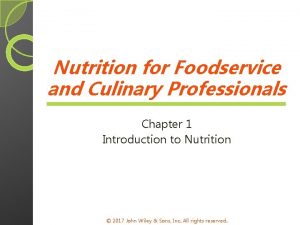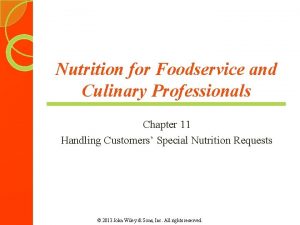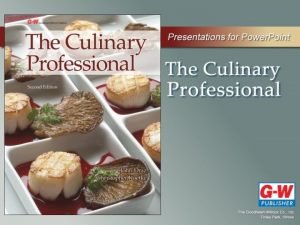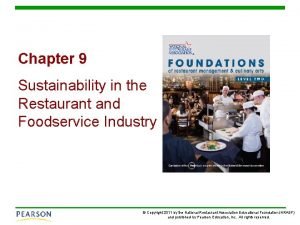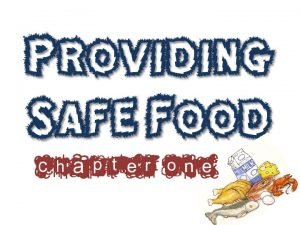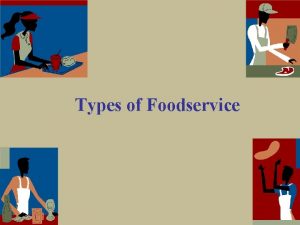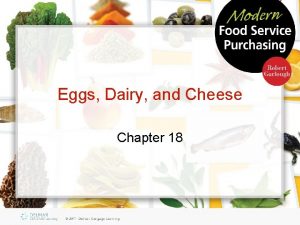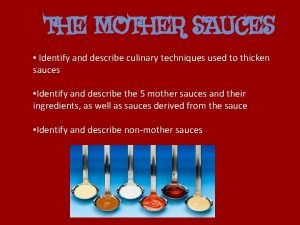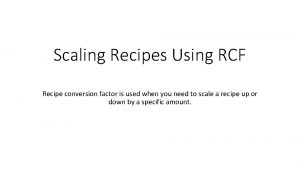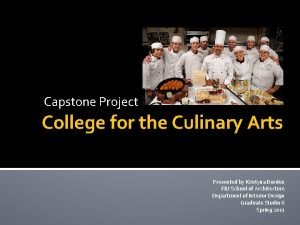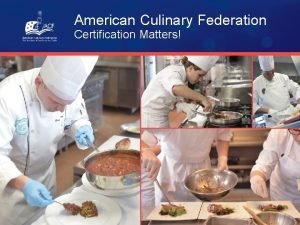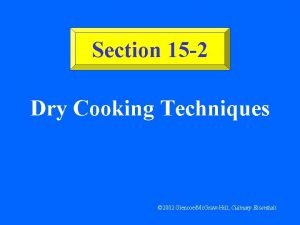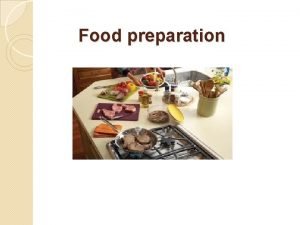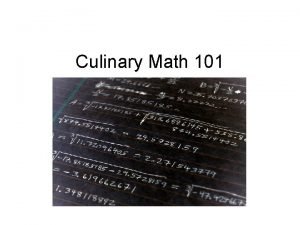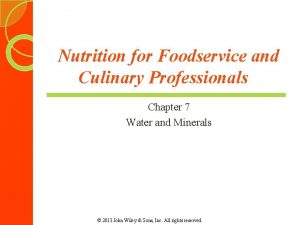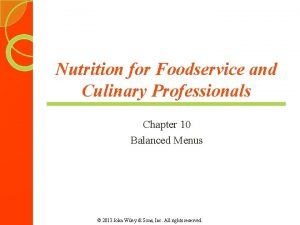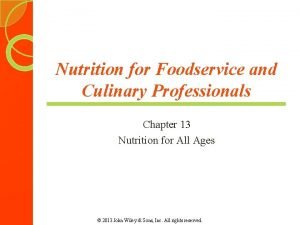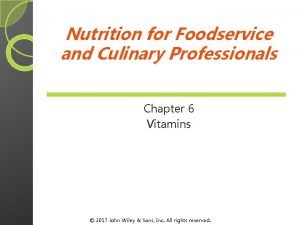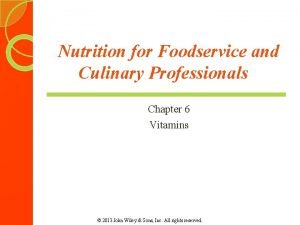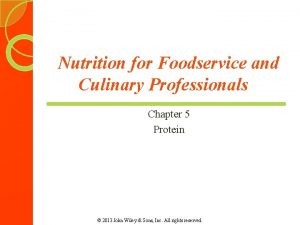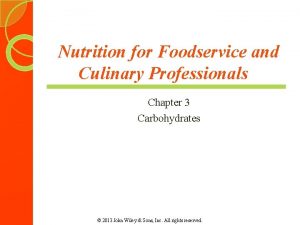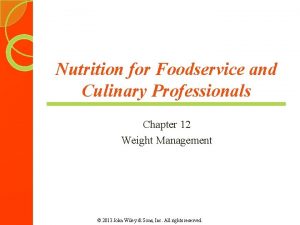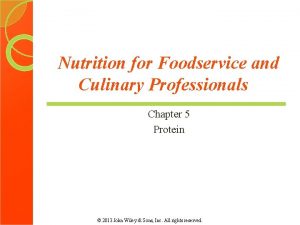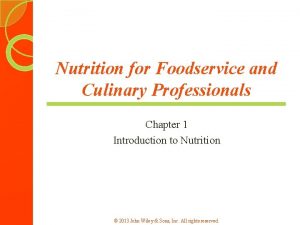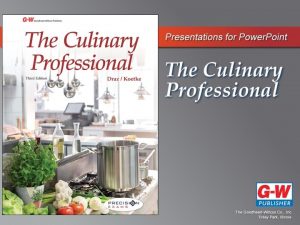Nutrition for Foodservice and Culinary Professionals Chapter 8











































- Slides: 43

Nutrition for Foodservice and Culinary Professionals Chapter 8 Balanced Cooking Methods and Techniques

Learning Objectives Explain the difference between a seasoning and a flavoring ingredient and give examples of each. � Identify appropriate times for adding seasoning and flavoring ingredients to the cooking process for best flavor. � Identify common herbs, spices, and blends used in the kitchen and be familiar with each one’s aroma, flavor, and effect on food. � Discuss how to develop a flavor profile for a menu item, including five examples of flavor builders you could use. � Explain how to use the following techniques to add flavor: reduction, searing, deglazing, sweating, puréeing, rubs, and marinades. � Describe how to use the following cooking methods in balanced cooking: sauté and dry sauté, stir-fry, roast, broil, grill, steam, poach, and braise. � Explain the functions of basic baking ingredients and techniques to make healthier baked goods. � © 2013 John Wiley & Sons, Inc. All rights reserved.

Introduction �The typical American buys a meal or snack from a foodservice operation about three to five times/week. �Americans depend on chefs, cooks, and foodservice employees to prepare nutritious foods for them. �Vast majority of operators promote balanced choices. © 2013 John Wiley & Sons, Inc. All rights reserved.

Balanced Menu Items Quality ingredients and taste are important considerations for balanced menu items. © 2013 John Wiley & Sons, Inc. All rights reserved.

Flavor �Seasonings: Substances used to bring out a flavor that is already present. �Flavorings: Substances used to add a new flavor or modify the original flavor. �Herbs: Leafy parts of certain plants that grow in temperate climates. �Spices: Roots, bark, seeds, flowers, buds and fruits of certain tropical plants. Mostly available dried. © 2013 John Wiley & Sons, Inc. All rights reserved.

Cooking with Herbs and Spices �Fresh herbs can only withstand about 30 minutes of cooking, so they work best for finishing dishes, tossing in before serving, or in other accompaniments such as fresh salsas. �Dried herbs work well in longer cooking applications. �Whole spices take longer to release flavors than ground spices. © 2013 John Wiley & Sons, Inc. All rights reserved.

Pepper and Red Pepper � Pepper comes in three forms: ◦ black ◦ white ◦ green � Black pepper is only used in dark-colored foods. � Ground white pepper is chosen by most good cooks as the true seasoning pepper. �Red pepper, also called cayenne, is NOT related to white or black pepper. It comes from dried red pepper pods and has a spicy hot profile. © 2013 John Wiley & Sons, Inc. All rights reserved.

Herbs and Spices © 2013 John Wiley & Sons, Inc. All rights reserved.

Basil �Warm, sweet flavor �Used in soups, sauces, entrées, relishes, salsas, and dressings �Used with vegetables such as tomatoes, eggplant, and peppers �Used in salads © 2013 John Wiley & Sons, Inc. All rights reserved.

Oregano �Belongs to the same herb family as basil �Strong, bittersweet taste, and perfume aroma �Italian, Mediterranean, Spanish, South American, and Mexican cuisine © 2013 John Wiley & Sons, Inc. All rights reserved.

Tarragon �Pleasant perfume like flavor that is somehow mild and strong at the same time �Licorice qualities �Most often used in poultry and fish dishes, as well as in salads, sauces, and cold dressings © 2013 John Wiley & Sons, Inc. All rights reserved.

Rosemary �The leaf of an evergreen shrub �Often used in dishes in which a liquid is involved—soups, stews, stocks, etc. �Used with poultry, beef, lamb, pork, tomato preparations �Dried rosemary should be strained. © 2013 John Wiley & Sons, Inc. All rights reserved.

Dill �Classic flavor of dillflavored pickles �Also used in soups, fish dishes, stews, complex salads, butters �Delicate flavor with flowery undertones © 2013 John Wiley & Sons, Inc. All rights reserved.

Mint �A sweet herb. �Available in a number of varieties such as apple, banana, black, English, and spearmint. �Fresh mint is a good flavoring and garnish for fruits, vegetables, salsas, relishes, salads, dressings, mixed greens, iced tea, desserts, and sorbets. © 2013 John Wiley & Sons, Inc. All rights reserved.

Paprika and Chili Peppers � Paprika � Chili ◦ Two flavors: mild and hot ◦ Hungarian paprika: hot and spicy, used to make Hungarian goulash (braised dishes) ◦ Spanish paprika: mild in flavor and vibrant red color, used for coloring, blending with rubs, and mild seasoning ◦ Turns brown under excessive heat ◦ ◦ peppers Contain capsaicin Range from mild to hot Used in Mexican, Asian, Thai, Peruvian, Indian, Cuban, and South American cuisines Chili powder blends also available—from smoked, dark, mild, and hot blends to single varietal © 2013 John Wiley & Sons, Inc. All rights reserved.

Curry Powder �Blend of spices, containing as many as 15 different kinds, such as cloves, black and red peppers, cumin, garlic, ginger, cinnamon, coriander, fennel, etc. �Originated in India and South Asia �Ranges from mild to hot © 2013 John Wiley & Sons, Inc. All rights reserved.

Sweet Aromatic Spices �Used in baking, dessert cookery, sauces, stews, marinades, rubs, vegetables, and entrees Spices. Top row, left to right: cloves, nutmeg, allspice, cinnamon sticks. Bottom row, left to right: juniper berries, cardamom, saffron, star anise. © 2013 John Wiley & Sons, Inc. All rights reserved.

Toasting Spices � To toast a spice: 1. Place a sauté pan on medium to high heat for about 1 minute. 2. Add the spices in the dry pan. 3. Toss quickly, being careful not to burn, until a nutty aroma is extracted from the spices. � Once cool, finely grind and store in an airtight container. � Use as a seasoning agent in applications such as marinades, rubs, dressings, soups, stews, ragouts, salsas, and relishes. © 2013 John Wiley & Sons, Inc. All rights reserved.

Spice Blends � Many herbs and spices can be combined to produce blends with global seasonings adding distinctive flavors, such as: ◦ Italian: garlic, onion, basil, oregano, crushed red pepper, thyme ◦ Asian: ginger, five-spice powder, garlic, scallion, Thai basil, cilantro ◦ French: tarragon, mustard, chive chervil, shallot ◦ South American: chili peppers, lime juice, garlic, cilantro, onion ◦ Indian: ground nutmeg, fennel, coriander, cinnamon, fenugreek, curry ◦ Mediterranean: oregano, marjoram, thyme, pepper, coriander, onion, garlic © 2013 John Wiley & Sons, Inc. All rights reserved.

Flavor Profiles �To ◦ ◦ ◦ plan your menu item, go through these steps: Identify the meal period. Identify what flavor direction you want to go in, such as a sweet profile in a dessert. Choose the main feature item with sides or garnishes. Consider how the dish will be presented. Consider combinations of flavor ingredients, such as cilantro with lime, onion, and cumin. © 2013 John Wiley & Sons, Inc. All rights reserved.

Flavor Profiles (cont’d) � To achieve maximum flavor, use techniques discussed in this chapter such as: ◦ Toasting and grinding spices ◦ Reducing liquids ◦ Marinating ◦ Using fresh herbs and good fortified stocks ◦ Picking appropriate cooking methods to maximize the potential of each dish ◦ Add fat at the end ◦ Poach and cook grains and legumes in flavored stock © 2013 John Wiley & Sons, Inc. All rights reserved.

Powerhouses of Flavor Fresh herbs and toasted spices � Herbs and spice blends � Freshly ground pepper � Citrus juices, citrus juice reductions � Strong-flavored vinegars and vinaigrettes � Wines � Strong-flavored oils such as walnut oil and extra-virgin olive oil � Infused vinegars and oils � Reduced stock (glazes) � Rubs and marinades � Raw, roasted, or sautéed garlic � Caramelized onions and shallots � Roasted bell peppers, chili peppers � Grilled or oven-roasted vegetables � Coulis, salsas, relishes, chutneys, mojos � Dried foods: tomatoes, cherries, cranberries, raisins � Fruit and vegetable purees � Condiments such as Worcestershire sauce, hot chili sauce, Dijon mustard � Natural, pure extracts � © 2013 John Wiley & Sons, Inc. All rights reserved.

Balanced Preparation �Reduction �Searing �Deglazing �Sweating �Puréeing �Rubs ◦ ◦ Wet or dry Just before cooking for delicate items At least 24 hours for large cuts of meat Flavors the exterior of the meat © 2013 John Wiley & Sons, Inc. All rights reserved.

Marinades � Marinades allow a food to stand on its own with a light dressings, chutney, sauce, or relish, for example. � Usually contains an acidic ingredient (wine, vinegar, citrus, yogurt, tomato juice) to break down tough meat or poultry. � Oil is used to carry flavor but isn’t essential. � To give marinated foods flavor, try citrus zest, diced vegetables, fresh herbs, shallots, garlic, low-sodium soy sauce, mustard, and toasted spices. � Besides tomato, adding chopped kiwi or pineapple to a marinade helps soften tough cuts. © 2013 John Wiley & Sons, Inc. All rights reserved.

Balanced Cooking Methods �Dry-heat cooking methods are acceptable for balanced cooking when heat is transferred with little or no fat. Excess fat is allowed to drip away from food being cooked. �Both pan frying and deep frying add varying amounts of fat and kcalories, so they are not acceptable cooking methods. © 2013 John Wiley & Sons, Inc. All rights reserved.

Sauté and Dry Sauté �Sautéing can be made acceptable by using nonstick pans, healthy oils, and at times finishing with a small amount of butter. �Use a well-seasoned or nonstick pan and add about half a teaspoon or two sprays of oil/serving after preheating the pan. �A quick two-second spray adds about 1 gram of fat to the product. © 2013 John Wiley & Sons, Inc. All rights reserved.

Sauté and Dry Sauté (cont’d) � To dry sauté, heat a nonstick pan, spray with vegetable-oil cooking spray, then wipe out the excess with a paper towel. Heat the pan again, then add the food. � Add shallots, garlic, or other seasonings, then deglaze the pan with stock, wine, or another liquid and reduce to a sauce consistency. � If browning is not important, you can simmer the ingredient in a small amount of liquid such as wine, vermouth, flavored vinegar, juices, or defatted stock to bring out the flavor. (Vegetables can be cooked with little or no added fluid at a high heat. ) © 2013 John Wiley & Sons, Inc. All rights reserved.

Sauté and Dry Sauté (cont’d) �Another sauté method is to blanch vegetables in boiling water to the desired doneness and then shock them in ice water or lay out on towels and place in the refrigerator. �Dry sauté in a hot nonstick pan with stock, wine, fresh herbs, garlic, and chopped shallots and finish with fresh black pepper and extra virgin olive oil, butter, or a first pressed nut oil (1 teaspoon for four servings). © 2013 John Wiley & Sons, Inc. All rights reserved.

Stir-fry � First, coat the cooking surface with a thin layer of oil such as peanut oil, which has a strong flavor so you can use a small amount. Have all your ingredients ready. Preheat the pan to a high temperature. � Foods that require the longest cooking times should be the first ingredients you start to cook. Stir the food rapidly during cooking and don’t overfill the pan. � Use garlic, scallion, ginger, rice wine vinegar, lowsodium soy sauce, and chicken/vegetable stock for flavor. � Add a little sesame oil at the end for taste (about 1 teaspoon per four servings). © 2013 John Wiley & Sons, Inc. All rights reserved.

Roasting �When roasting, always place meats and poultry on a rack so they don’t cook in their own drippings. �You can add flavor when roasting, broiling, or grilling by using rubs, marinades, or smoking, and also by deglazing the roasting pan to make either jus or jus lié. © 2013 John Wiley & Sons, Inc. All rights reserved.

Jus and Jus Lié � To give jus additional flavor, � Cook the jus at a moderately add a mirepoix to the roasting high heat so they brown or pan during the last 30 to 40 caramelize. minutes. � Add stock and a little wine to � To remove most of the fat from deglaze the pan. the jus, you can use a fat� Stir the ingredients to release separator or skim off the fat the food from the pan because with a ladle. If time permits, you want that flavor. you can refrigerate the jus and � Continue to add stock to cover, the fat will congeal at the top. then reduce the jus until the � To make jus lié, remove the fat color is appropriate. from the jus, then add some � You can thicken if you want vegetables. with a cornstarch slurry. © 2013 John Wiley & Sons, Inc. All rights reserved.

Smoke-Roasting—Pan Smoking � Works best with smaller, tender items such as chicken breast, fish fillet, vegetables, and seafood but it also can be used to add flavor to larger pieces. � Place about a half-inch of soaked wood chips in the bottom of a roasting pan or hotel pan lined with aluminum foil. � Next, place the seasoned food on a rack sprayed with vegetable spray and reserve. Heat the pan over moderate -high heat until the wood starts to smoke, then lower the heat. � Place the rack over the wood and cover the pan. Keep covered until the food has the desired smoke flavor, then complete the cooking in the oven if the food is not yet done. © 2013 John Wiley & Sons, Inc. All rights reserved.

Flavorful Sauces for Roasted, Broiled, or Grilled Foods �Chutneys �Relishes �Purées �Mojos �Coulis �Salsas �Compotes �Vinaigrettes © 2013 John Wiley & Sons, Inc. All rights reserved.

Grilling and Broiling � Grilling � Broiling ◦ Cook meat and poultry at higher temperatures than seafood and vegetables. ◦ Don’t grill thin fish fillets as they will fall apart. ◦ Spray food with olive oil or baste it with marinade, stock, wine, or reduced-fat vinaigrette during cooking. ◦ To finish, sprinkle a thin layer of Japanese breadcrumbs and glaze under the broiler. © 2013 John Wiley & Sons, Inc. All rights reserved.

Moist Heat Cooking � In moist-heat cooking of meat or poultry, the danger is that the fat in the meat or poultry will stay in the cooking liquid. This problem can be resolved to a large extent by chilling the cooking liquid so that the fat separates and can be removed. � Moist-heat cooking methods do not add the flavor that dry-heat cooked foods get from browning, deglazing, or reduction. To be successful, you will need good fortified stocks or jus, well-trimmed seasoned meats and skinless poultry, and seasonings such as wine and fresh herbs. © 2013 John Wiley & Sons, Inc. All rights reserved.

Steaming and Poaching � Introduce flavor into steamed and poached foods by adding herbs, spices, citrus juices, and other flavorful ingredients to the water. � For example, fish is often poached in a court bouillon, a flavorful liquid. � Steaming and microwaving are excellent ways to cook vegetables. © 2013 John Wiley & Sons, Inc. All rights reserved.

Braising Steps 1. 2. 3. 4. 5. Trim the fat. Season the meat or poultry. In a small amount of oil in a brazier, sear the meat or poultry to brown it to develop flavor. Remove the meat and any excess oil from the pan. Put the pan back on the heat. Add vegetables and caramelize (brown) them. Deglaze the pan with wine and stock, being sure to scrape the fond. © 2013 John Wiley & Sons, Inc. All rights reserved.

Braising Steps (cont’d) 6 7 8 Add tomato paste, wine, stock, and aromatic vegetables. Reduce. Return the meat to the brazier, cover, and put into the oven, covered to simmer. Make sure the meat is three-quarters covered with liquid, so the meat cooks evenly and prevents the bottom from getting scorched. When the meat is done, strain the juices. Skim off fat and reduce the juices. Purée the veggies and use them to thicken the jus. © 2013 John Wiley & Sons, Inc. All rights reserved.

Hot Topic: Healthy Baking �Flour—provides gluten (protein) and structure. Bread flour has the most protein and cake flour has a lot less gluten. �Eggs—are high in protein, so they give structure. Eggs also contribute flavor, color, and tenderness. �Fats—provides moisture and help give baked goods their tender crumb. �Sugar—provides sweetness and keeps baked goods moist and tender. © 2013 John Wiley & Sons, Inc. All rights reserved.

Healthy Baking �Healthy baking means finding a balance between structure and moisture. The main ingredients that give structure are flour and eggs, while fats and sugar give tenderness and moisture. Wet ingredients also act as moisteners. �If you want to decrease or eliminate an ingredient from a recipe, consider what the ingredient does. You can use another ingredient that performs the same job—such as using more sugar to tenderize when decreasing fat, or you can reduce the amount of ingredients that have opposite effects. © 2013 John Wiley & Sons, Inc. All rights reserved.

Tips for Reducing Fat/Sat Fat �Use oils instead of solid fats. Oils can’t completely substitute for fats when creaming is essential to leavening. �If you reduce the fat in a recipe you need to increase other tenderizing ingredients (such as sugars), decrease ingredients that toughen the product (such as switch to cake flour or use fewer eggs), or do both. �Use two egg whites in place of one whole egg. © 2013 John Wiley & Sons, Inc. All rights reserved.

Tips for Reducing Sugar �You can often reduce the amount of sugar in a recipe for 10 percent or more. �To make up for sugar, you can use flours with less gluten or dairy products such as fat-free yogurt. �Also use spices to boost sweetness. © 2013 John Wiley & Sons, Inc. All rights reserved.

Tips for Specific Baked Goods � Cake tips: Light cakes rely less on fat and more of sugar and liquids for a tender texture. Don’t overbeat once the flour is added, and don’t overbake. � Pie crusts: Make sure you coat the flour proteins with fat and don’t overwork the dough. � Cookies: Don’t use soft margarine, whipped butter, or diet margarines because they contain too much water. Light cookies require precise measuring of the flour especially. Watch oven carefully to get out at the right time. � Quick breads: They are much more versatile than other baked goods in terms of making a variety of tasty, healthful versions. © 2013 John Wiley & Sons, Inc. All rights reserved.
 Nutrition for foodservice and culinary professionals
Nutrition for foodservice and culinary professionals Nutrition for foodservice and culinary professionals
Nutrition for foodservice and culinary professionals Nutrition for foodservice and culinary professionals
Nutrition for foodservice and culinary professionals Chapter 11 culinary nutrition
Chapter 11 culinary nutrition Chapter 7 activity guide culinary
Chapter 7 activity guide culinary Chapter 3 foodservice career options
Chapter 3 foodservice career options Understanding foodservice operations chapter 2
Understanding foodservice operations chapter 2 Sustainability in the restaurant and foodservice industry
Sustainability in the restaurant and foodservice industry Which food is a tcs food
Which food is a tcs food Chapter 4 becoming a culinary professional answers
Chapter 4 becoming a culinary professional answers Chapter 14 culinary math
Chapter 14 culinary math What are the types of food service
What are the types of food service Production sheets food service
Production sheets food service Industrial institutional commissary food service
Industrial institutional commissary food service Commercial food service operation
Commercial food service operation Commissary food service system
Commissary food service system Lincoln foodservice products
Lincoln foodservice products Noncommercial food service examples
Noncommercial food service examples Tabletop foodservice equipment on legs
Tabletop foodservice equipment on legs Taylor commercial foodservice
Taylor commercial foodservice Nnn foodservice solutions
Nnn foodservice solutions Culinary crossword 9.1 eggs and dairy
Culinary crossword 9.1 eggs and dairy Scip competitive intelligence
Scip competitive intelligence Families professionals and exceptionality
Families professionals and exceptionality Ctip for acquisition and contracting professionals
Ctip for acquisition and contracting professionals Families professionals and exceptionality
Families professionals and exceptionality Rondelle definition cooking
Rondelle definition cooking Chef culinary conference
Chef culinary conference Mother sauces and derivatives
Mother sauces and derivatives Rcf formula culinary
Rcf formula culinary La harbor college nursing
La harbor college nursing What is culinary math
What is culinary math Culinary words
Culinary words Army records information management system
Army records information management system Culinary arts study guide
Culinary arts study guide Cooking terms jeopardy
Cooking terms jeopardy Culinary capstone project
Culinary capstone project Acf certification
Acf certification Joint culinary center of excellence
Joint culinary center of excellence Crosshatch markings culinary
Crosshatch markings culinary Define food preparation
Define food preparation Culinary crossword 2.1 fire safety
Culinary crossword 2.1 fire safety Culinary math
Culinary math Rancidity meaning
Rancidity meaning
